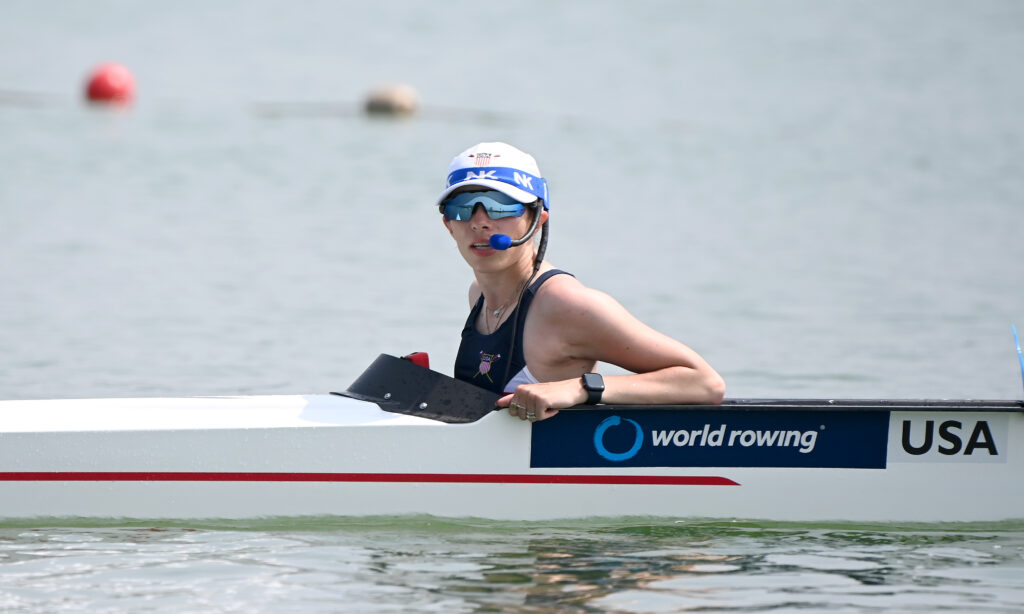
26 Jun 2025
New research paper sheds light on how top coxswains cox
How do coxswains influence a race? That was the key question asked in a piece of research carried out recently by a team led by University of Limerick associate professor in sports science Frank Nugent, working alongside British Olympic medallist Zoe de Toledo, Eoghan Myers and Limerick skill acquisition specialist Phil Kearney.
The research analysed eight recordings of races coxed by elite coxswains to work out the types of calls they were making, how they made them, and how much they talked during a race. Now, Nugent and his fellow authors are hoping the study will help influence further work into an under-researched area of sport.
“Having been a rower myself and sat in a boat with some good coxes and some coxes who maybe weren’t so good, I know that when you get a great cox they can make a boat, and they’re so hard to find,” says Nugent.
He explains that only three pieces of research have previously been carried out on coxing, and none had analysed what coxswains say or how they delivered information to a crew, despite the importance of coxswains to the sport of rowing both in training and racing.
The Limerick research analysed YouTube to source recordings of races at the Olympic Games, World Rowing Championships, World Rowing Cups, European Rowing Championships or Henley Royal Regatta finals and semi-finals – classifying coxswains in these events as ‘elite’. In total, 16 recordings were found and eight were eligible for the study. They were then transcribed and analysed to code calls as internally focused, externally focused or holistically focused cues, as well as the tone and manner of the calls.
The analysis revealed that over 40 per cent of calls were technical calls, predominantly with an internal focus directed at body movements; there was some limited use of externally focused calls talking about the boat or blades. Another 38.6 per cent of calls were motivational and 21 per cent were tactical, talking about making a change or where the boat was in the race. Coxes made an average of 32 calls per minute.

Nugent says these types of focus cues are widely researched, and previous research suggests an external focus is more beneficial than an internal focus.
“A lot of research indicates that if we keep on saying to someone ‘squeeze X muscle’ or ‘move this joint’, you become so focused on moving that muscle or that joint that you forget the other muscles,” he explains, adding that an external focus can shift attention away from what the body is doing.
However, he adds: “Sometimes it can be hard to make external focus of attention cues suitable for rowers.”
But the use of holistic cues – such as “stay loose” – can help a rower to reduce their conscious focus over a particular movement.
“The last thing a lot of rowers want to hear halfway through a 2k is ‘keep your wrists flat’ or ‘squeeze your glutes’,” Nugent says.
He says the way coxswains talk to their crews showed how an elite coxswain is a master of communication, and there would be scope for further research into how communication changed over the course of a race.
“There was practically no silence throughout a race,” he says. “It’s a fairly big demand on someone to talk non-stop for five and a half to seven minutes, and it’s much higher than observed in other team sports. Coxing is a real niche specialised skillset that deserves a lot more research in the future.”
Nugent says coxswains interested in the research can read the whole paper online [https://journals.sagepub.com/doi/10.1177/17479541251335448#bibr26-17479541251335448], and should start by looking at the illustrative chart which shows how the research analysed the calls that were being made, and how that might relate to their own coxing.
“We did our best attempt at teasing out why is there so much focus on internal focus of attention cues in rowing,” he says.
Nugent says there is plenty of scope for more research into coxing, particularly a study looking at how coxswains were selected for a particular boat that could provide evidence to help coaches in that process. Other areas that could be studied include how coxswains relay the ever-increasing amount of data they are collecting from telemetry or cox boxes back to their crews, or the role they have in motivation and leadership.
“Coxing is a real niche specialised skillset that deserves a lot more research in the future,” Nugent believes.
He says the input from Kearney and de Toledo was invaluable for this study, and encourages coxswains to read the paper and reach out with questions or potential input for future research.

